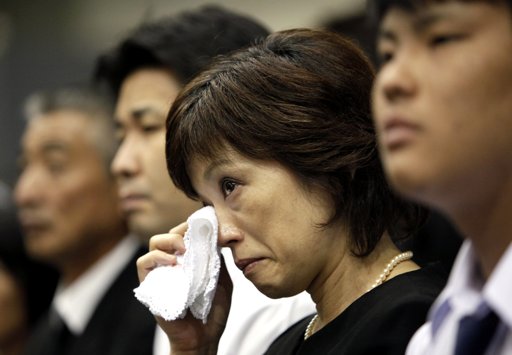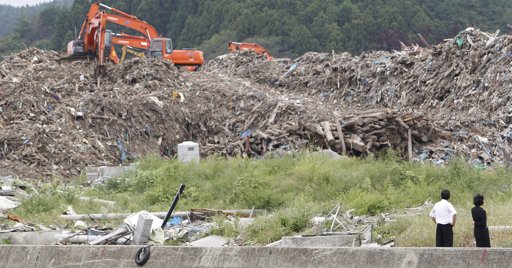By TOMOKO A. HOSAKA - Associated Press | AP – September 11, 2011

A woman weeps during the memorial service for the victims of the March 11 earthquake and tsunami, marking six months after the disasters in Kesennuma, Miyagi Prefecture, northeastern Japan, Sunday, Sept. 11, 2011.(AP Photo/Koji Sasahara)

A couple look on a heap of rubble made by destroyed houses by the March 11 earthquake and tsunami after attending a memorial service marking six month after the disasters in Minamisanriku, Miyagi Prefecture, northeastern Japan, Sunday, Sept. 11, 2011. As the world commemorates the 10th anniversary of the World Trade Center attacks, Sunday is doubly significant for Japan. It marks exactly six months since the massive disasters. (AP Photo/Koji Sasahara)
TOKYO (AP) — As the world commemorates the 10th anniversary of the World Trade Center attacks, Sunday is doubly significant for Japan. It marks six months since the massive earthquake and tsunami on March 11, a date now seared in the national consciousness.
Up and down the hard-hit northeast coast, families and communities came together to remember victims. Monks chanted. Survivors prayed. Mothers hung colorful paper cranes for their lost children.
At precisely 2:46 p.m., they stopped and observed a minute of silence. March 11 changed everything for them and their country.
The magnitude-9.0 earthquake produced the sort of devastation Japan hadn't seen since World War II. The tsunami that followed engulfed the northeast with waves that reached as high as 130 feet (40 meters) and wiped out entire towns. It inundated (淹没) the Fukushima Dai-ichi nuclear power plant, triggering the worst nuclear accident since Chernobyl (切尔诺贝利:苏联欧洲部分中西部城市,位于基辅西北偏北。是1986年4月16日的一场核能大事故的所在地。).
Some 20,000 people are dead or missing. More than 800,000 homes were completely or partially destroyed. The disaster crippled businesses, roads and infrastructure. The Japanese Red Cross Society estimates that 400,000 people were displaced.
Half a year later, there are physical signs of progress.
Much of the debris has been cleared away or at least organized into big piles. In the port city of Kesennuma, many of the boats carried inland by the tsunami have been removed. Most evacuees have moved out of high school gyms and into temporary shelters or apartments.
But beyond the surface is anxiety and frustration among survivors facing an uncertain future. They are growing increasingly impatient with a government they describe as too slow and without direction.
Masayuki Komatsu, a fisherman in Kesennuma, wants to restart his abalone (鲍鱼) farming business.
But he worries about radiation in the sea from the still-leaking Fukushima (福岛[日本本州岛东北部城市] ) plant and isn't sure if his products will be safe enough to sell. He said officials are not providing adequate radiation information for local fisherman.
"I wonder if the government considers our horrible circumstances and the radiation concerns of people in my business," said Komatsu, who also lost his home.
Another resident, 80-year-old Takashi Sugawara, lost his sister in the tsunami and now lives in temporary housing. He wants to rebuild his home but is stuck in limbo (1.不安定的状态; 2.遗忘) for the time being.
"My family is not very wealthy, and I only wish that the country would decide what to do about the area as soon as possible," Sugawara said.
He might be waiting for a while. The Nikkei financial newspaper reported this week that many municipalities in the hardest-hit prefecture (辖区, 县) of Miyagi (宫崎[日本九州岛东南岸港市]), Iwate (
岩手) and Fukushima have yet to draft reconstruction plans.
Of the 31 cities, towns and villages severely damaged by the disaster, just four have finalized their plans, the Nikkei said. The scale of the disaster, the national government's slow response and quarrels among residents have delayed the rebuilding process.
Criticism of the government's handling of the disaster and nuclear crisis led former Prime Minister Naoto Kan to resign. Former Finance Minister Yoshihiko Noda took over nine days ago, becoming Japan's sixth new prime minister in five years.
He spent much of Saturday visiting Miyagi and Iwate prefectures, promising more funding to speed up recovery efforts and trying to shore up confidence in his administration.
But the trip was overshadowed later in the day by his first big political embarrassment. Noda's new trade minister Yoshio Hachiro resigned, caving into intense pressure after calling the area around the nuclear plant "a town of death," a comment seen as insensitive to nuclear evacuees.
Public support for the new government started out strong, with an approval rating of 62.8 percent in a Kyodo News poll released last Saturday. Hachiro's resignation will likely translate into a drop and new doubts about Noda's ability to lead.
Regardless of politics, what's clear is that the road ahead will be long.
"Given the enormous scale of the destruction and the massive area affected, this will be a long and complex recovery and reconstruction operation," Tadateru Konoe, president of the Japanese Red Cross Society, said in a statement. "It will take at least five years to rebuild, but healing the mental scars could take much longer."
___
APTN Videojournalist Miki Toda in Kesennuma contributed to this report.

